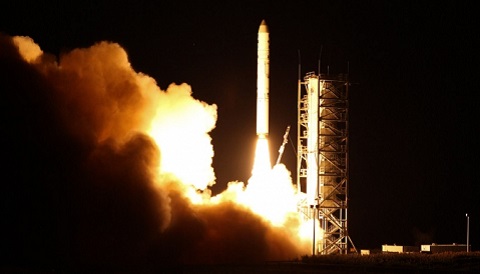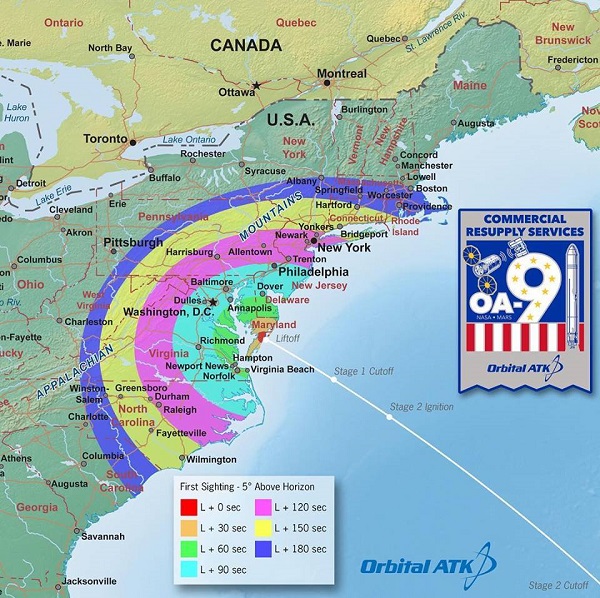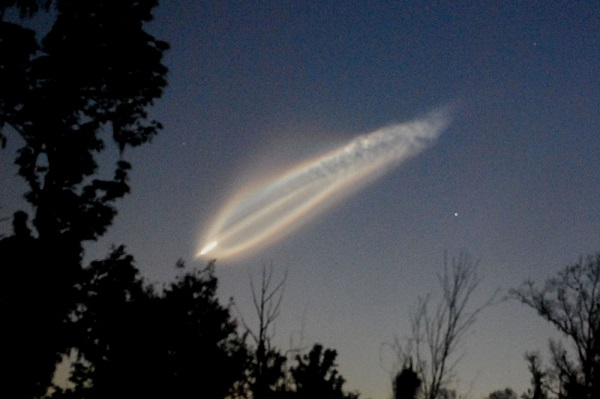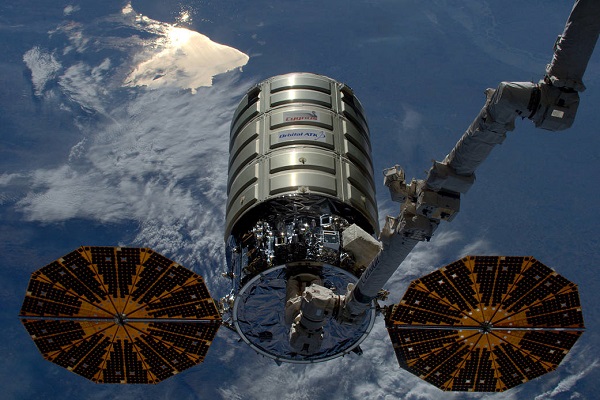The Cygnus OA-9 mission launching from Wallops Island early Sunday morning could put on quite a show along the East Coast.

NASA
Update: NASA has rolled the OA9 launch out of Wallops back to Monday morning at 8:39 UT/4:39 AM EDT due to weather.
If you live along the East Coast — and if skies are clear (always a big 'if” for the U.S. Eastern Seaboard in late Spring) — there's a rare opportunity to witness a rocket launch on Sunday morning.
Orbital ATK will launch a two-stage Antares rocket from Launch Complex 0 at NASA's Mid-Atlantic Regional Spaceport (MARS) on Wallops Island, Virginia. Barring delays, liftoff will occur on the morning of May 20th. The five-minute launch window opens at 5:04 a.m. EDT / 9:04 UT, about 50 minutes before local sunrise. Cygnus OA-9 is an automated resupply mission, with cargo headed to the International Space Station (ISS). OA-9 is Orbital ATK's 10th planned flight of Cygnus.

Orbital ATK
The geometry for the launch couldn't be better. Sunlight streaming over the eastern curve of the Earth will hit the exhaust plume from the Antares rocket just after liftoff. Two of the best launches that I've ever witnessed from our former home north of Tampa Bay, which was 100 miles to the west of the Kennedy Space Center/Cape Canaveral launch complex, were brilliant predawn launches: STS-131 and the MUOS-4 launch.

Dave Dickinson
Both launches also left a neon-blue trail of noctilucent clouds that lingered for over half an hour until sunrise. The Cygnus/Antares launch Sunday could do the same.
In the event of a weather or technical delay, the extended window for the launch runs through the week, and moves about 25 minutes earlier every day.
You may also see Cygnus's final destination passing overhead on Sunday morning as well: A fine visible pass of the ISS will occur over the eastern United States during the launch window, at around 5:07 a.m. EDT / 9:07 UT. The station will head from northwest to southeast on this pass, following the same trajectory that Cygnus and Antares will take headed out over the Atlantic.
To the west, U.S. and Canada will see Cygnus and the Antares Castor second stage chase the ISS over the first few orbits Sunday morning. You can check for visible ISS passes using S&T's ISS Tracker or on Heavens-Above.
While viewing circumstances favor the Chesapeake Bay area, from Washington D.C. down to Norfolk Virginia and Virginia Beach, viewers from Boston down to central South Carolina — a good swath of the U.S. population — could see the launch if skies are clear.
Weather Prospects
Now, for the bad news. As of Friday morning, weather prospects for the next 48 hours are mixed. On the plus side, launch viewing is like eclipse chasing in that you don't necessarily need clear skies from horizon to zenith, just a clear view of the event. On the down side, most viewers will see the launch low to the horizon, and even a small scud of clouds could hide it. The very worst launches I've seen from the Florida Space Coast were the ones where low cloud cover hung over the site: There's a flash, a roar of the rocket engines — then the launch plume quickly disappears into the low cloud deck. The MAVEN launch was just like that.

NWS / NOAA
The best places to check out cloud cover prospects are:
- NOAA/National Weather Service's cloud cover forecast
- Skippy Sky (this also breaks down the outlook by low, middle and high cloud cover)
- Clear Sky Chart
- And when I'm mobile, I like to use the Clear Outside App
Imaging the ISS and the launch is as simple as taking a time exposure shot using a tripod mounted DSLR at the appointed time. On previous launches, I've had good luck taking a series of quick, 5 second exposures with a 18-200 zoom lens, a pretty simple setup.
Clouded out? NASA TV will carry the launch live online as well, starting at 4:30 a.m. EDT / 8:30 UT.
Chasing Cygnus and Friends
But the hunt doesn't end there. If Cygnus launches Sunday morning, it will arrive at the ISS on Thursday, May 24th at 5:20 a.m. EDT / 9:20 UT. If you've got a visible ISS pass, watch for the fainter “star” of Cygnus chasing down the station.

NASA
We're also entering a special time of year as we head towards the June solstice, a time known as "high beta angle season," when the ISS is illuminated over the entire span of its orbit. This occurs because the station's orbit is inclined 51.6° relative to the equator, in order to make it accessible to launch sites worldwide. A nifty side benefit of this is that nearly all of humanity can spot the station, from latitude 60°N to 60°S. While the December solstice season favors the southern hemisphere, the June solstice favors the north. In fact, from UK latitudes around 50°N to 60°N, it's possible to get four to five consecutive visible ISS passes in one night.
This first round starts early, with the ISS entering full illumination next week on May 20th at 11:56 UT. It won't start hitting the Earth's shadow again until three days later on May 23rd at 21:55 UT. During this time, the massive solar panels of the station are also feathered a bit to create artificial shadow to help deal with over-heating.
We'll be watching launch and ISS passes alike from our apartment rooftop in downtown Norfolk if skies are clear. Follow us on Twitter as @Astroguyz, as we'll be curating the OA-9 and viewing prospects before, during, and after the launch.
Let us know if you see it!
 2
2









Comments
Joe Stieber
May 18, 2018 at 12:27 pm
As of Friday, May 18, 2018, the Antares launch has been delayed until Monday morning, May 21 at 4:39 am EDT, evidently due to bad weather prospects. The way the weather looks now, I wouldn’t be surprised if it’s delayed yet again. I’m in the Philadelphia suburbs of New Jersey (roughly 150 miles north of Wallops Island) and have been watching Wallops launches from this area for many years. Occasionally, we head south to the north shore of the Delaware Bay or to Cape May, NJ, for an even closer view.
I’ve also been looking forward to the upcoming four and five ISS pass nights next week. I’ve seen five in one night several times before. I was also looking forward to a very bright ISS pass concurrent with the original launch time. Oh well.
You must be logged in to post a comment.
David DickinsonPost Author
May 18, 2018 at 6:16 pm
Yup... thanks, I'm seeing that update now. Not surprised, the weather is pretty cruddy here around Norfolk this weekend... now, to try and get up at 4:00 AM on a Monday morning...
You must be logged in to post a comment.
You must be logged in to post a comment.